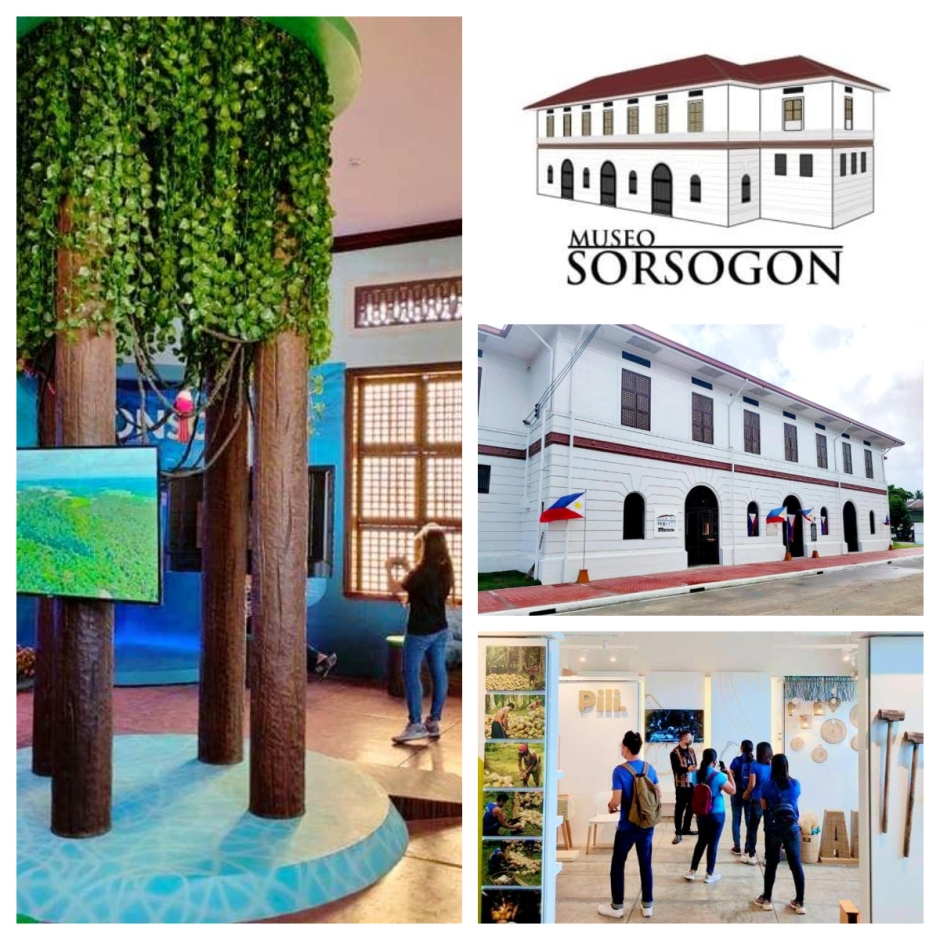Dear readers, do you know that there is a new historical and cultural hub in Sorsogon? Want to know more? Allow Tita S to tell you a dozen facts about it.
1.The Museo Sorsogon is a new museum in Barangay1 Burabod, in the Provincial Capitol compound of the province2 of Sorsogon3, Sorsogon City4, in the Bicol5 Region6, in the island of Luzon7, Philippines.
2. The two-storey museum is located at the Old Sorsogon Provincial Jail. The latter was built in 1916, and also hosted the Court of First Instance, a symbol of the justice system in the province2.
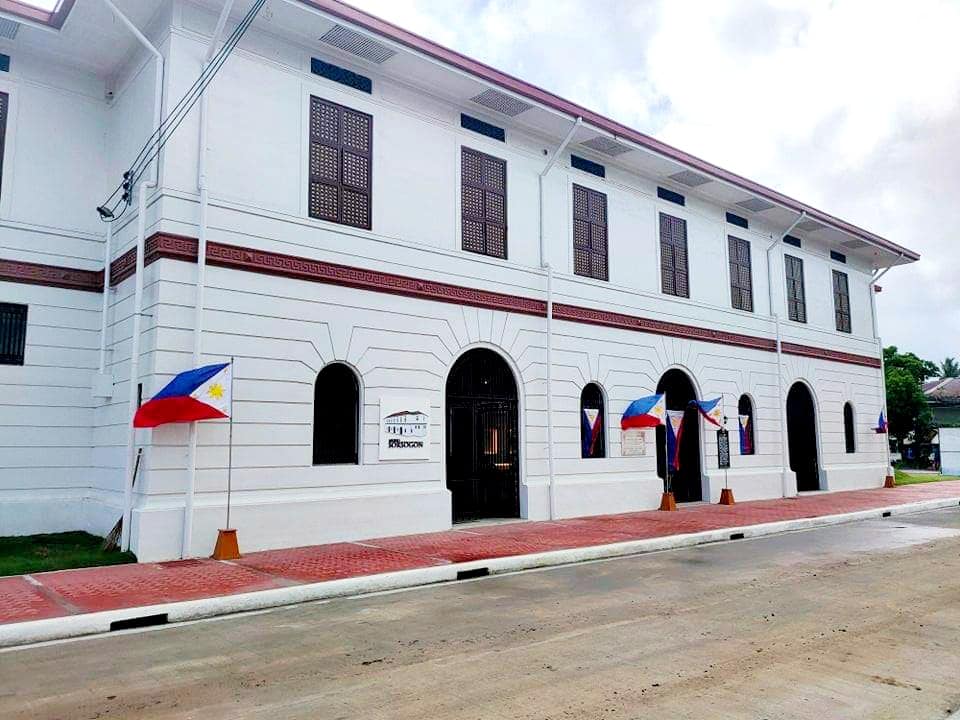
Facade, daytime – Photo source: Museo Sorsogon Facebook, https://www.facebook.com/105504924710260/photos/pb.100063894590424.-2207520000../237871494806935/?type=3
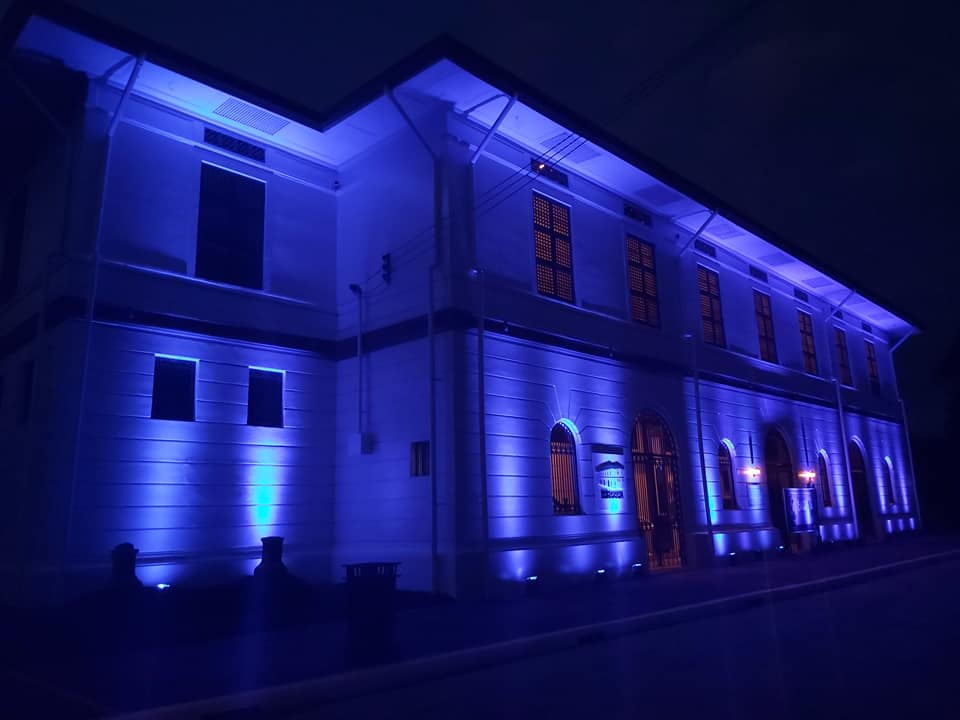
At night – Photo source: Museo Sorsogon Facebook, https://www.facebook.com/105504924710260/photos/pb.100063894590424.-2207520000../216752450252173/?type=3
This project was the brainchild of Governor Francis Joseph G. Escudero when a new penitentiary was built, and the inmates were transferred in 2019. He saw the potential of the vacated building and decided to showcase the province’s history, culture and heritage.

Photo source: Museo Sorsogon Facebook, https://www.facebook.com/photo/?fbid=105507061376713&set=a.248477677292050
The property was restored by the Department of Public Works and Highways.
3. The ten galleries of this museum display significant historical and cultural artifacts and memorabilia of the province2 which highlight its early settlers and settlement, participation in the 1896 Philippine Revolution, status during the American Occupation8, and locally-made products. Relevant artifacts are continuously collected.
The total area per floor is about 830 sqm (to be verified).
Galleries 1 to 5 are located on the first floor of the building:
Gallery 1, called “Ang Lalawigan ng Sorsogon: Ang mga Bayan at Lungsod Nito” (The Province2 of Sorsogon3: Its Municipalities9 and City), showcases 5 areas:
* Ang Pinagmula ng Pangalan ng Sorsogon (The Origin of the Name of Sorsogon)
* Heograpiya ng Sorsogon (The Geography of Sorsogon)
* Ang Klima at mga Importanteng Producto ng Sorsogon (Climate and Important Sorsogon Products)
* Populasyon ng Sorsogon (The Population of Sorsogon)
* Mga Wika ng Sorsogon (Sorsogon Languages)
Pic-11A-fb- 2021 April 24
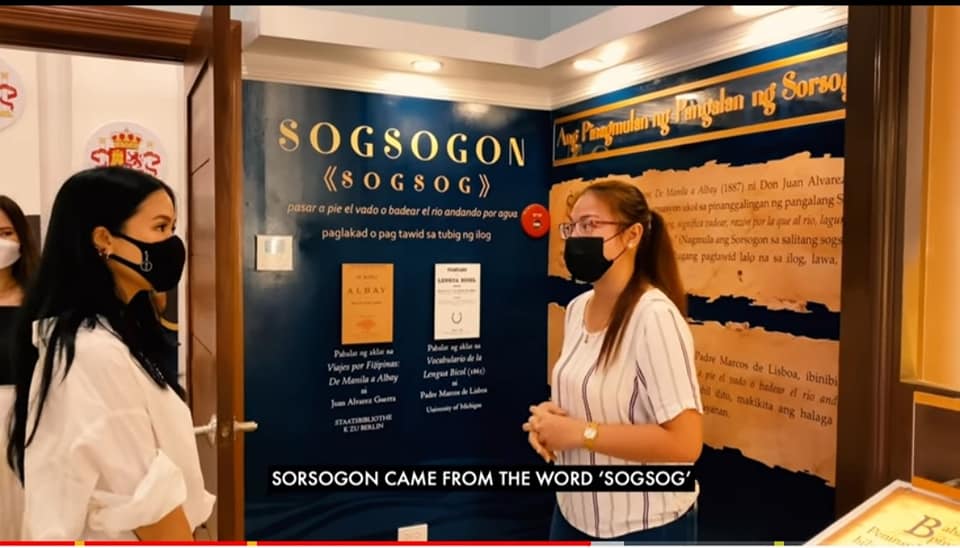
Gallery 1 – Photo source: Museo Sorsogon Facebook, https://www.facebook.com/105504924710260/photos/pb.100063894590424.-2207520000../214624273798324/?type=3
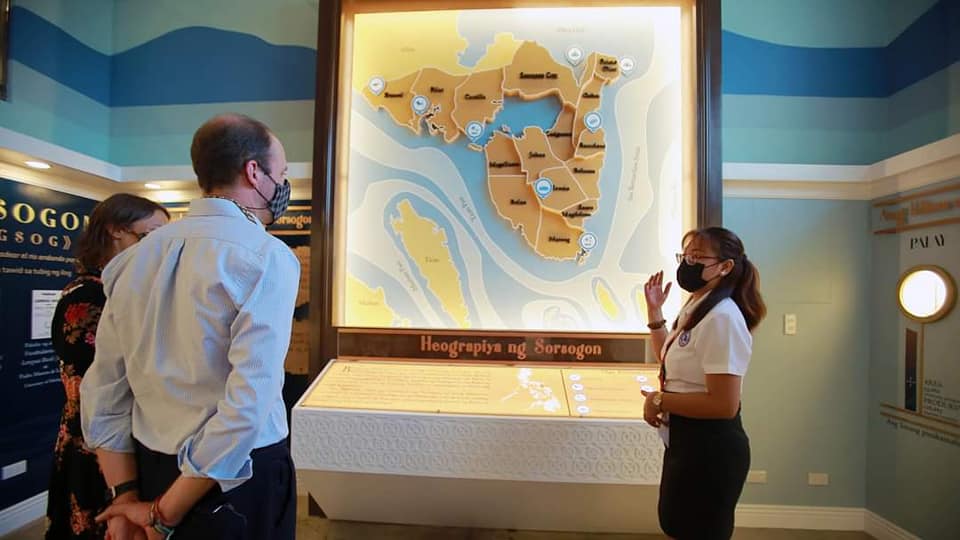
Gallery 1 – Photo source: Museo Sorsogon Facebook, https://www.facebook.com/105504924710260/photos/pb.100063894590424.-2207520000../213354220591996/?type=3
Gallery 2, called “Panahong Prehistoriko at Pagsisimula ng mga Pamayanan” (The Prehistoric Period and the Beginning of Communities), reveals 4 particulars:
* Ang mga Kuweba ng Bato (The Caves of Bato)
* Ang Libingan sa Pilar (The Cemetery of Pilar)
* Ang Pagsisimula ng mga Sinaunang Pamayanan (The Beginning of Early Settlements)
* Mga Alamat ng Lawa ng Bulusan (Legends of Lake Bulusan)

Gallery 2 – Photo source: Museo Sorsogon Facebook, https://www.facebook.com/105504924710260/photos/pb.100063894590424.-2207520000../196376745623077/?type=3
Gallery 3, called “Sorsogon noong Panahon ng mga Espanyol” (Sorsogon3 during the Spanish Period), contains 10 displays:
* Ang Misa sa Gibal-ong (Gibalon) Magallanes (The Mass of Gibalon, Magallanes)
* Ang Misyon ng mga Pransiskano sa Sorsogon (The Franciscan Mission in Sorsogon)
* Erecciones de Pueblos y Parroquias: Pagtatatag ng mga Bayan noong ika-17 Daantaon (The Establishment of Towns and Parishes During the 17th Century)
* Pag-aalsa sa Sorsogon (Uprising in Sorsogon)
* Astilleros: Ang Halaga ng Sorsogon sa Kalakhang Galyon (The Importance of Sorsogon in the Galleon Trade)
* Ang mga Pagsalakay ng mga Pirata sa Sorsogon (The Pirate Attacks in Sorsogon)
* Baluartes, Estacadas y Castillos: Ang mga Tanggulan at Moog sa Sorsogon (Bastions, Stockades and Castles: The Forts and Towers in Sorsogon)
* Ang mga Bahay-na-Bato ng Sorsogon (The Stone Houses of Sorsogon)
* Mga Tradisyong Relihiyoso sa ibat-ibang Bayan ng Sorsogon (Religious Traditions in the Different Towns of Sorsogon)
* Ang Espesyal na Debosyon kay Ina, Nuestra Señora de Peñafrancia10 sa Sorsogon (The Special Devotion to our Mother, Our Lady of Peñafrancia of Sorsogon).
Gallery 4, called “Rebolusyon sa Sorsogon” (Sorsogon3 Revolution), presents 3 parts:
* Kronolohiya ng mga Kaganapan (Chronology of Events)
* Si Obispo Jorge Barlin sa Sorsogon (Bishop Jorge Balrin11 of Sorsogon)
* Ang mga “Pulahanes” sa Sorsogon (The “Pulahanes”12 of Sorsogon).
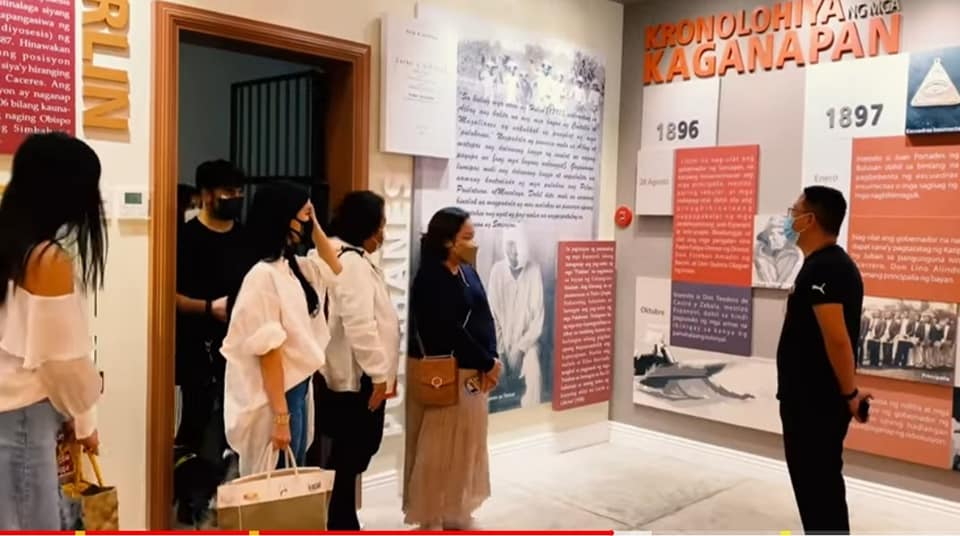
Gallery 4 – Photo source: Museo Sorsogon Facebook, https://www.facebook.com/105504924710260/photos/pb.100063894590424.-2207520000../214624293798322/?type=3

Gallery 4 – Photo source: Museo Sorsogon Facebook, https://www.facebook.com/105504924710260/photos/pb.100063894590424.-2207520000../213354260591992/?type=3
Gallery 5, called “Sorsogon sa Pananakop ng mga Amerikano” (Sorsogon3 During the American Occupation8), shows 8 details:
* Pagdating ng mga Amerikano (The Arrival of the Americans)
* Ang mga “Amerikanistas” at mga Anti-Amerikano; Ang Pagkilos ni Lt. Col. Emeterio Funes (The “Amerikanistas” and the Anti-Americans: The Action of Lt. Col. Emeterio Funes13)
* Pagtatanggol ng Donsol Laban sa mga Amerikano (Donsol’s Defense Against the Americans)
* Mga Gurong Amerikano (Thomasites) at ang Pampublikong Edukasyon sa Sorsogon (The American Teachers (Thomasites14) and Public Education in Sorsogon)
* Larawan ng Bagong Kaayusan (A Portrait of the New Order)
* Pampublikong Istraktura (Public Structures)
* Pagsupil sa Kolera (Cholera Control)
* Sa Ilalim ng Pamahalaang Komonwelt (Under the Commonwealth Government15)
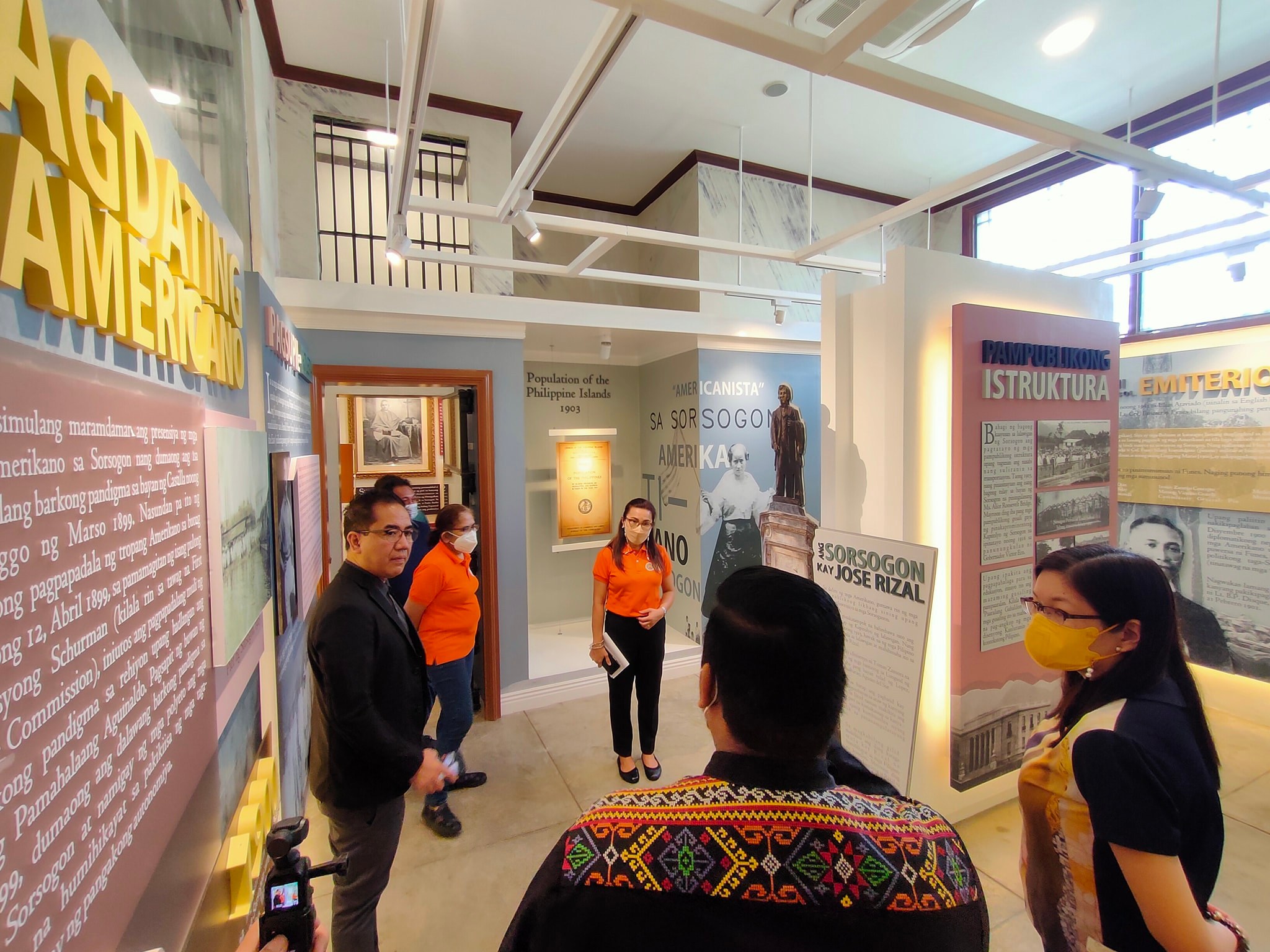
Gallery 5 – Photo source: Museo Sorsogon Facebook, https://www.facebook.com/photo.php?fbid=327500262723124&set=pb.100063894590424.-2207520000..&type=3

Gallery 5 – Photo source: Museo Sorsogon Facebook, https://www.facebook.com/105504924710260/photos/pb.100063894590424.-2207520000../213354280591990/?type=3
Galleries 6 to 10 are located on the second floor:
Gallery 6, called “Sorsogon sa Pananakop ng mga Hapon” (Sorsogon3 During the Japanese Occupation16), uncovers 7 scenes:
* Ang Ikalawang Digmaang Pandaigdig at ang Pananakop ng Sorsogon (The Second World War and the Conquest of Sorsogon)
* Mga Gerilla ng Sorsogon: Ang Gerilla Yunit ni Lapus (Sorsogon Guerillas17: The Guerilla Unit of Lapus18)
* Mga Gerilla ng Sorsogon: Ang Gerilla Yunit ni Escudero (Sorsogon Guerillas: The Guerilla Unit of Escudero19)
* Ang mga War Tunnel ng Bulan (The War Tunnels of Bulan)
* Ang Masaker ng mga Tsino ng Bulan (The Massacre of the Chinese of Bulan)
* Ang Pagtatapos ng Digmaan (The End of the War)
* Mga Bayaning Gerilya ng Sorsogon (Guerilla Heroes of Sorsogon)
Pic-8B-fb- 2021 March 27
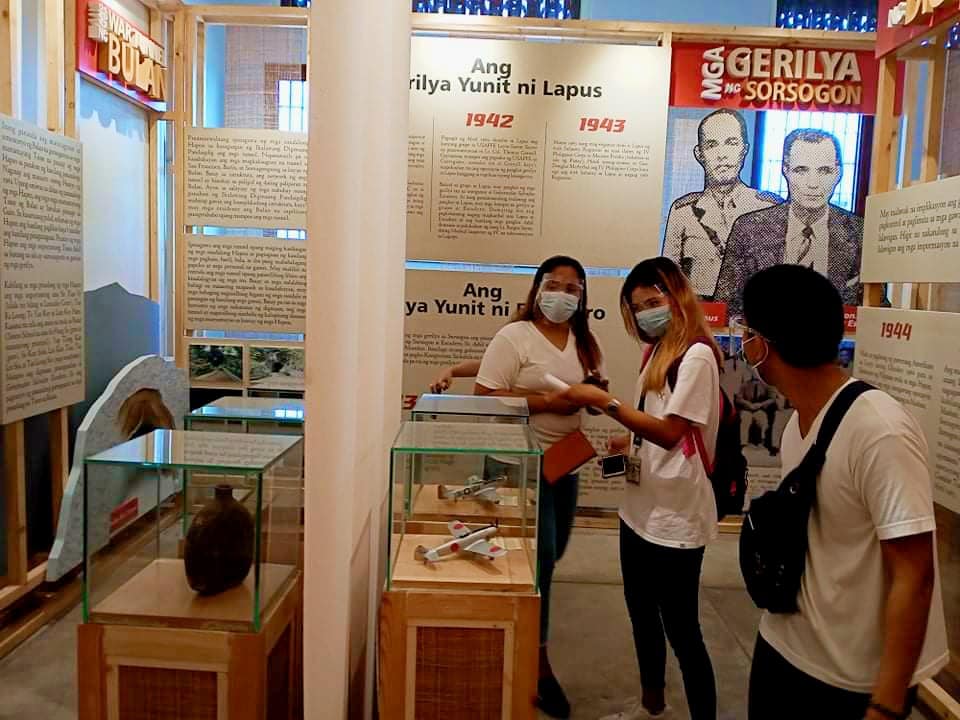
Gallery 6 – Photo source: Museo Sorsogon Facebook, https://www.facebook.com/105504924710260/photos/pb.100063894590424.-2207520000../196376465623105/?type=3
Gallery 7, called “Pagbangon at Pag-unlad” (Rise and Development), reveals 3 points:
* Mga Anak ng Sorsogon sa Panahon ng Batas Militar hanggang sa People Power (Sorsogueños During Martial Law Until People Power20)
* Mga Mapaminsalang Bagyo (Destructive Typhoons)
* Mga Aktibidad bg Bulkang Bulusan (The Activities of Mount Bulusan)
Gallery 8, called “Mga Industriya ng Sorsogon” (Sorsogon Industries), features 4 products: niyog (mature coconut), pagpapanday (blacksmithing), pili (pili nut) and abaka (abaca)
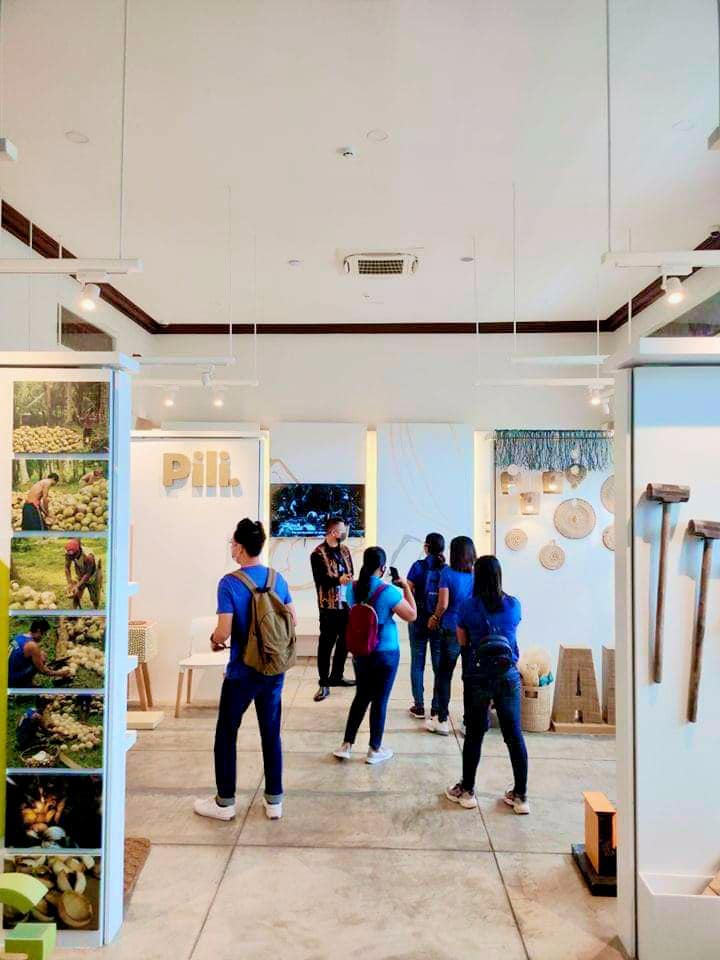
Gallery 8 – Photo source: Museo Sorsogon Facebook, https://www.facebook.com/105504924710260/photos/pb.100063894590424.-2207520000../196376518956433/?type=3
Gallery 9, called “Pantomina sa Tinampo”, exhibits 2 events:
* Kasanggayahan Festival21
* Pantomina sa Tinampo22 (Traditional Courtship Folk Dance, Guinness World Record Title Holder 2019)
Gallery 10, called “Mga Pook Pasyalan sa Sorsogon”, displays 4 features:
* Isla, Dagat, Dalampasigan (Island, Sea, and Beach)
* Anyaya ng Inang Kalikasan (Invitation of Mother Nature)
* Paglalakbay na Makasaysayan (Historical Journey)
* Mayamang Kultura at Pananampalataya (Rich Culture and Faith)

Gallery 10 – Photo source: Museo Sorsogon Facebook, https://www.facebook.com/105504924710260/photos/pb.100063894590424.-2207520000../213354330591985/?type=3
4. The yard, at the back of the museum, was converted into an 875-sq.m. open-air amphitheater, with a six-tier seating area. It can be a venue for events and stage performances.

Photo source: Museo Sorsogon Facebook, https://www.facebook.com/105504924710260/photos/pb.100063894590424.-2207520000../207628101164608/?type=3
5. The Kape-Terya (Cafeteria) and the Kape-Tolyo (coffee shop) are dining areas located at the back of the museum, inside the amphitheater. The former offers local snacks; the latter offers both hot and cold coffee to museum visitors. They help make the museum more sustainable.

Kape-tolyo – Photo source: Museo Sorsogon Facebook, https://www.facebook.com/105504924710260/photos/pb.100063894590424.-2207520000../177207384206680/?type=3
6. The Provincial Government of Sorsogon3 partnered with the Department of Trade and Industry (DTI) so that micro, small and medium enterprises can display their “made in Sorsogon” products in the Souvenir Shop, located at the entrance of the museum. Snacks, beauty products made from pili, handicrafts, and accessories are sold with no price mark-up.
7. The museum also features the original artworks of the provincial jail inmates, like the Sputnik gang’s rendition of the portrait of Cuban revolutionary Che Guevara.
8. There is also a restored mural of Lady Justice (Justitia) at the second floor, in Gallery 8. It was painted by a certain V. L. Jesalva.
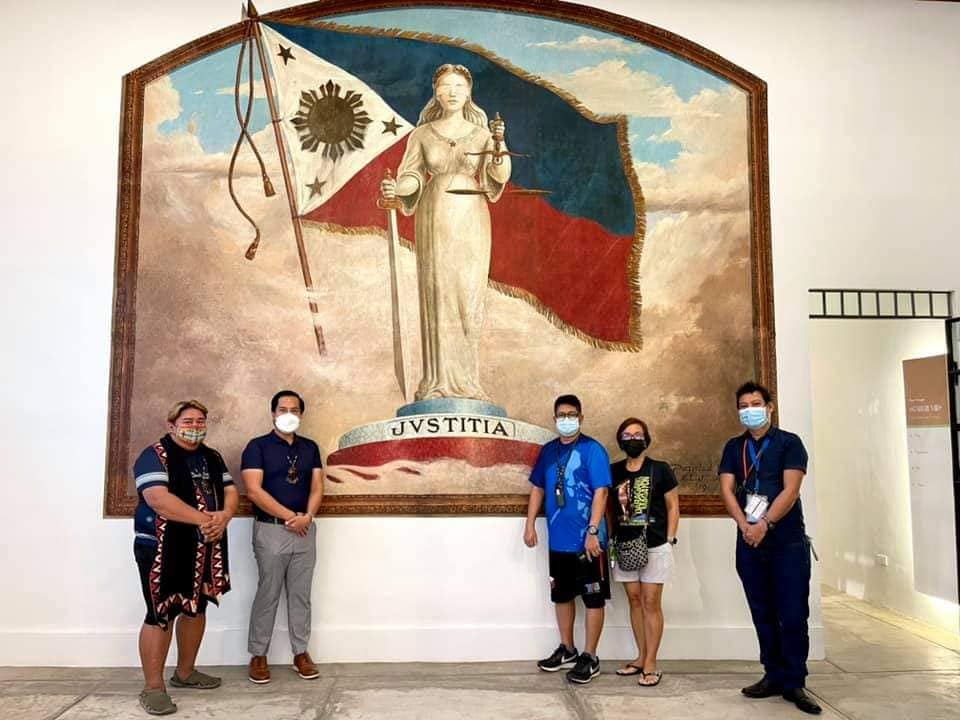
Photo source: Museo Sorsogon Facebook, https://www.facebook.com/photo.php?fbid=260982636041554&set=pb.100063894590424.-2207520000..&type=3
9. The National Historical Commission of the Philippines (NHCP) managed the curatoria development of this new museum and restored the Justitia mural. It also facilitated the loans of important artifacts from the National Museum of the Philippines.
The NHCP formally turned over the museum to the Sorsogon Provincial Government on March 12, 2021, during its inauguration and blessing. NHCP Chairman Rene R. Escalante presented the Certificate of Turn-over to Governor Francis Joseph G. Escudero, and the latter spearheaded the unveiling ceremonies.
10. The museum was blessed by Sorsogon Bishop Jose Alan V. Dialogo.
The inauguration was also attended by Deputy Speaker Evelina G. Escudero, National Museum of the Philippines Director-General Jeremy R. Barns, Sorsogon Vice Governor Manuel L. Fortes, Jr., Sorsogon City Mayor Ma. Ester E. Hamor, and other local government officials.
11. Museo Sorsogon opened to the public on March 15, 2021, from 8:30-11:30 AM and 1:00-4:30 PM, Monday to Friday.
Visitors must be 15-65 year-old, and bring a valid ID with birthday, and own pencil (no ballpen please) to fill up the forms in the museum.
Good news – for now, admission is free, but visitors are required to schedule their visits to prevent overcrowding due to the pandemic and follow safety protocols of the province and IATF23. No face mask and face shield, no entry! Do not bring any large backpack, food or drinks, and pets. There is an elevator for PWD guests.
Here are the guidelines through photos:
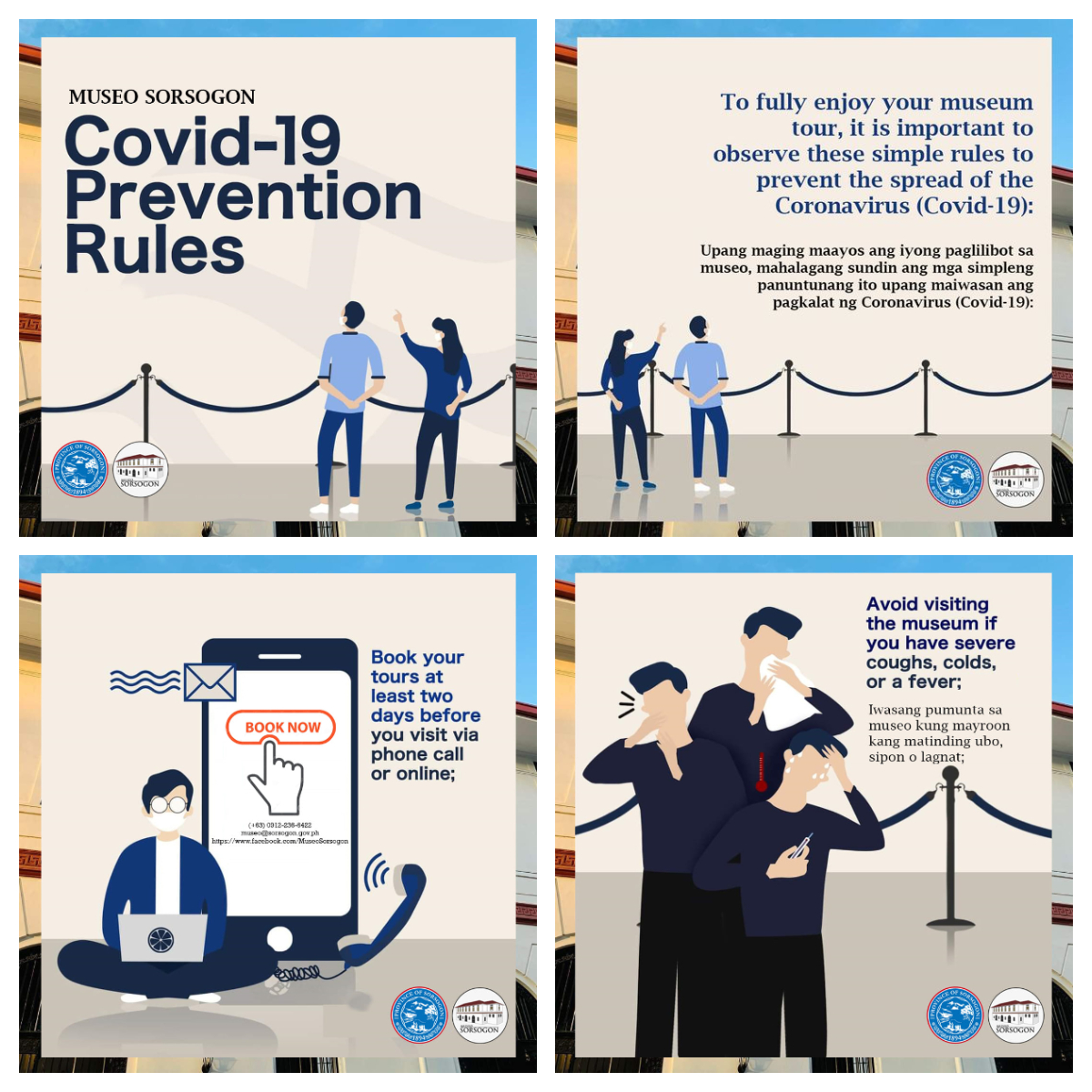

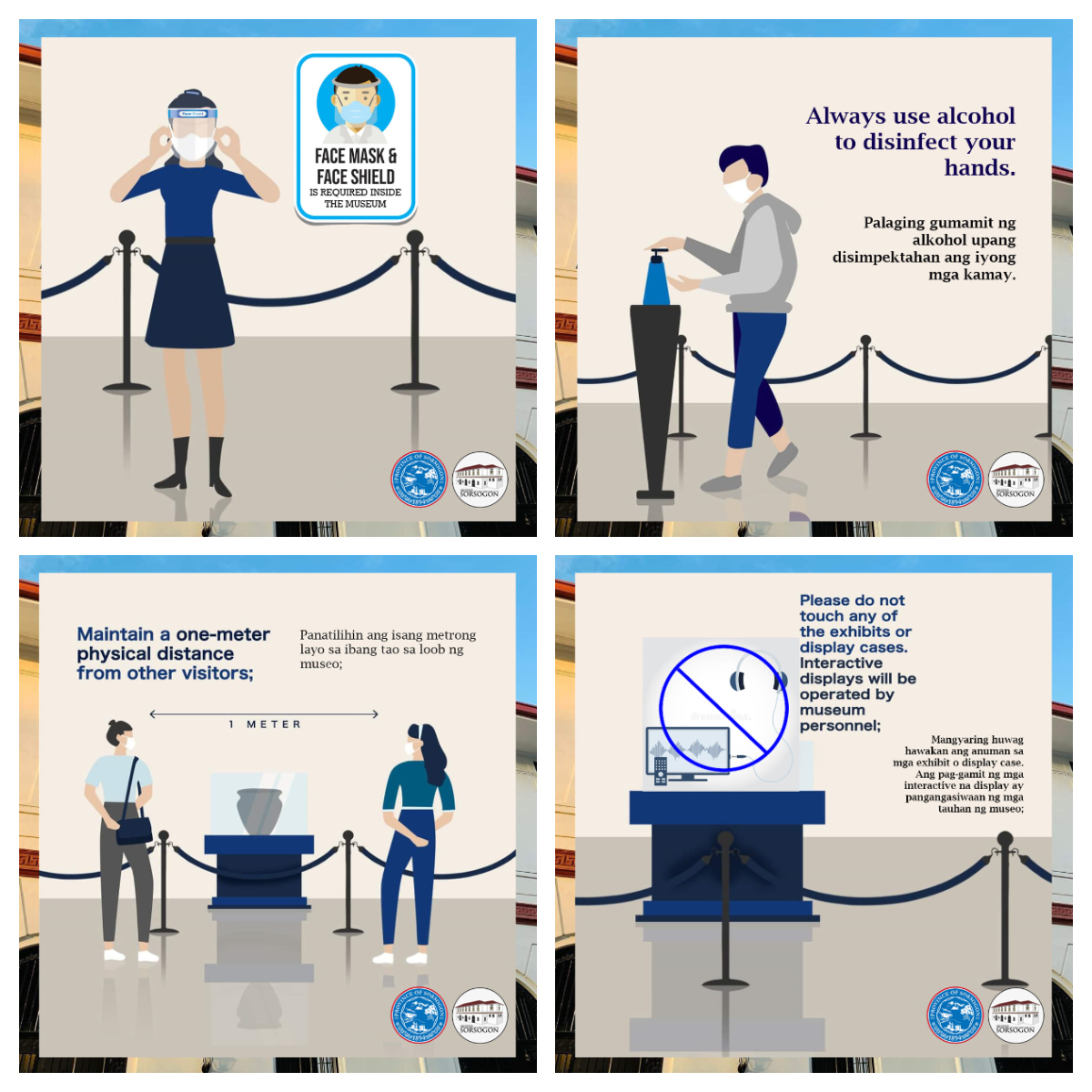

Groups with 10 or more members need to book two days ahead of their visit to be given a time slot and briefing. There is free parking space at the back of the Museo Amphitheater.
12. The fastest route from Manila to Bicol5 is via the Pan-Philippine Highway which has tolls, more or less 520 km from Manila. The Museum is located at the back of the Provincial Capitol building, and is visible in the City Proper.
You can email museo@sorsogon.gov.ph, call (+63) 0912-236-6422, or message https://www.facebook.com/MuseoSorsogon.
The information was obtained from the following sources: https://nhcp.gov.ph/nhcp-sorsogon-province-inaugurate-museo-sorsogon/, http://bicol.politics.com.ph/2021/03/15/gov-escudero-spearheads-unveiling-of-museo-sorsogon/, https://www.facebook.com/MuseoSorsogon, and https://thebicolbloc.com/sorsogon-museum-reopens-at-the-century-old-jailhouse-courthouse/ and Mr. Jerome D. Dia, Museo Sorsogon’s Museum Curator.
The photos featured in the cover picture-collage wers obtained from (l-r, top-bottom): Museo Sorsogon Facebook, https://www.facebook.com/105504924710260/photos/pb.100063894590424.-2207520000../196376632289755/?type=3, https://www.facebook.com/photo/?fbid=248477717292046&set=a.248477673958717, https://www.facebook.com/105504924710260/photos/pb.100063894590424.-2207520000../237871494806935/?type=3, and https://www.facebook.com/105504924710260/photos/pb.100063894590424.-2207520000../196376518956433/?type=3.
Tita S wishes to visit this place when it will be safe to do so for seniors. However, for Bicolanos, why not go to this new museum? Be proud of your history, culture and Sorsogon products! #MuseoSorsogon
By the way, I also featured Sorsogon in 4 previous posts, check out the 3 destinations and include them in your Sorsogon visit and tell me about it, ok?
THROWBACK – A THRILL OF A LIFETIME: SWIMMING WITH THE GENTLE GIANT – THE BUTANDING
PRETTY IN PINK – 3: SUBIC BEACH (Matnog, Sorsogon, Philippines)
PRETTY IN PINK – 4: TIKLING BEACH (Matnog, Sorsogon, Philippines)
THE FIRST MASS IN LUZON: MAGALLANES, SORSOGON
Did you find this post informative? I would like to hear from you re Museo Sorsogon.
See other interesting places through other posts in this category and other categories of SCapades, Pinoy Delights, and Smart Traveler – Now You Know, Short and Simple, and Say, Say, Say. Happy reading, and I hope that you will appreciate what I shared and some of the featured destinations will be part of your future travel plans!
Remember to share this post with your friends, follow me by clicking on the bottom right corner of your device, and do not forget to like this post. Thank you.
– – – – – – – – – – – – – – – – – – – – – – – – – –
The following terms are defined for interested readers, especially those with “Senior-Moments”, not familiar with the terms used in this post, and those too busy or lazy to Google such terms:
1A barangay in the Philippines is the smallest administrative division in the Philippines, headed by a barangay captain, aided by a Sangguniang Barangay (Barangay Council). It is the native Filipino term for a village. It was formerly called a barrio. In a metropolitan area, a barangay is an inner city neighborhood, a suburb, or a suburban neighborhood. The word barangay originated from the term balangay, a kind of boat used by a group of Austronesian people who migrated to the Philippines. A number of barangays grouped together is called a district. The information was obtained from Wikipedia page “Barangay.”24
2A province is the primary administrative and political division in the Philippines. It is the second-level administrative sub-division of a region6. There are 81 provinces (called lalawigan) in the Philippines. Each province is governed by an elected legislature called the Sangguniang Panlalawigan, and by an elected governor. Remember, a province in the Philippines is divided into cities and towns (called municipalities21), which in turn, are divided into barangays1, formerly called barrios. The information was obtained from Wikipedia page “Provinces of the Philippines.”25
3Sorsogon is a province2 located in the Bicol5 region6, in the island of Luzon7, in the Philippines, founded on October 17, 1894. It is the southernmost province in Luzon and is subdivided into 14 municipalities9 (or towns) and one city (Sorsogon City4, its capital). The people are called Sorsogueños.
It covers a total area of 2,119.01 km2 (818.15 sq.mi.). It is bordered by the province of Albay to the north, the Ticao and Burias Passes to the west and northwest, the Philippine Sea to the east, and to the south by the San Bernardino Strait. Mount Bulusan, the tallest peak, rises 1,560 m (5,120 ft) above sea level. It is interesting to know that all municipalities lie along the coast, except landlocked Irosin.
Sorsogon is the gateway of Luzon to the Visayas26 and Mindanao27 through its Roll-on/Roll-off ferry terminal facilities located in the municipalities of Matnog, Bulan and Pilar.
For more information, visit its website: www.sorsogon.gov.ph. The information was obtained from the Wikipedia page “Sorsogon”.28
4Sorsogon City is a 3rd class city29 and capital of the province2 of Sorsogon3, in the Bicol5 region6, in the island of Luzon7, Philippines. It is the only city in the province and was established as a component city30 created by virtue of Republic Act No. 8806, enacted on August 16, 2000, and ratified on December 16, 2000, from the merger of Bacon and Sorsogon municipalities9, with a total of 64 barangays1.
It is called the “Gateway to Southern Philippines” because it serves as a trans-shipment point from the provinces of the islands of Visayas26 and Mindanao27. It covers a land area of 31,292 hectares (120.82 sq.mi.). This city is bounded by the Albay Gulf in the north, the municipality of Manito (of the province of Albay) in the northwest, and the Sorsogon municipalities of Castilla in the west, Casiguran in the southwest, Prieto Diaz in the east, Gubat in the southeast, and Sorsogon Bay in the south.
The information was obtained from the Wikipedia page “Sorsogon City”.31
5Region V, or Bicol Region, is a Philippine region6 located in the island of Luzon7, with Legazpi as its regional center and largest city. It has 6 provinces2: Albay, Camarines Norte, Camarines Sur, Catanduanes, Masbate, and Sorsogon3. It is called the “Home of the Uragons”, referring to the brave Bicolano people.
This region is bounded by the Lamon Bay to the north, the Ragay Gulf to the west, and the Philippine Sea to the east. Camarines Norte and Camarines Sur, the northernmost provinces, are bordered to the west by the province of Quezon (of the Calabarzon region31).
The information was obtained from the Wikipedia page “Bicol Region”.32
6A region is an administrative division based on geographical, cultural and ethnological characteristics. Each region is further subdivided in provinces1, composed of cities and municipalities9 (or towns), which in turn, are divided into barangays1, formerly called barrios, according to Wikipedia page “Regions of the Philippines” 33.
7Luzon is the largest and most populous island in the Philippines. It is ranked the 15th largest island in the world by land area, at 109,964.9 sq.km. (42,457.7 sq mi). It is the northern portion, among the three primary island groups in the Philippine archipelago, with Visayas26 at the center, and Mindanao27 at the southern part. It is the economic and political center of the country, with Manila as the capital city, and Quezon City as the country’s most populous city. It has a population of 53 million, as of 2015, representing 52.5% of the country’s total population, and the fourth most populous island in the world. The name Luzon comes from the Tagalog word lusong, a large wooden mortar used to de-husk rice. The information was obtained from the Wikipedia page “Luzon”34 .
8The American colonization of the Philippines began when Spain ceded the Philippines to the United States with the signing of the Treaty of Paris35 on December 10, 1898, after the Spanish-American War36.
The interim US military government of the Philippine Islands37 experienced a period of great political turbulence, characterized by the Philippine-American War38. Starting 1901, the military government was replaced by a civilian government, the Insular Government of the Philippine Islands, with William Howard Taft as its first Governor-General. A series of insurgent governments ensued until 1904.
After the Philippine Independence Act of 1934, a Philippine presidential election was held in 1935, with Manuel L. Quezon elected and inaugurated President of the Philippines on November 15, 1935. The Insular Government was dissolved and the Commonwealth of the Philippines15 was created to be a transitional government in preparation for the country’s independence. On July 4, 1946, the United States formally recognized the independence of the Republic of the Philippines.
The information was obtained from the Wikipedia page “History of the Philippines (1898-1946)”.39
9A municipality is a small, single urban administrative division, or local government unit (LGU), in the Philippines which has corporate status and powers of self-government or jurisdiction as granted by law. It is a unit under a province2, subdivided into barangays1, and is locally called bayan. In the Philippines, a municipality is headed by a mayor, a vice mayor, and members of the Sangguniang Bayan (legislative branch). It can enact local policies and laws, enforce them, and govern its jurisdictions. It can enter into contracts and other transactions through its elected and appointed officials and can tax as well. It enforces all local and national laws. There are almost 1,500 municipalities in the Philippines. The information was obtained from Wikipedia page “Municipalities of the Philippines.”40
10Nuestra Señora de Peñafrancia, or Our Lady of Peñafrancia, is a wooden statue of the Blessed Virgin Mary venerated in Naga City41, in the Bicol5 region6, in the island of Luzon7, Philippines. This image came from the original image enshrined in Salamanca, Spain, and is housed at the Peñafrancia Basilica42, where every September, novena43 festivities are held. Pope Pius XI granted the image a Canonical coronation on September 20, 1924 through his Apostolic delegate, Monsignor Guillermo Piani. The information was obtained from Wikipedia page “Our Lady of Peñafrancia.”44
11Jorge Balrin (1850 – 1909) was the first Filipino who was consecrated a bishop in the Roman Catholic Church. He was the first Filipino and Bicolano bishop, and was parish priest and vicar forane45 of Sorsogon3 from 1887 to 1906. He served as archbishop of the Roman Catholic Archdiocese of Caceres46 in the Philippines until 1909. The information was obtained from Wikipedia page “Jorge Barlin.”47
12Pulahanes refers to the people who were members of a religious revival of Philippine beliefs that developed in the Visayas26, prior to the Philippine Revolution48. Pulahan literally means “those wearing red” in Cebuano, the most widely spoken of the Visayan languages. They are also called dios-dios, literally “god pretender” or “false god”, from the Spanish word for god, dios. They were called as such because their religious leaders had the penchant for identifying themselves with Christian religious figures, and led cult-like religious movements, promising prosperity, supernatural powers, or healing to their followers.
Their practices centered mostly on Philippine mythology, along with Folk Catholicism, and believed in anting-anting49 and the babaylan50 (shaman). They had religious rituals using bottles of holy oil, prayer books such as the Bible, consecrated anting-anting, as blessings before battles. They specialized in using a heavy crescent-shape bolo knife in their battles, and were regarded by the Americans as notorious fighters and experts in hand-to-hand combat.
The movement was started by Ponciano Elofre, the Cabeza de Barangay of Zamboanguita, Negros Oriental (a province in the Central Visayas region). Although it peaked with around 15,000 members, this movement was severely crippled during the Philippine Revolution after the Philippine Constabulary took over patrols in Samar, an island in eastern Visayas, and the US military declared the island as “pacified”.
The information was obtained from Wikipedia page “Pulahan.”51
13Lt. Col. Emeterio Escava Funes (1870 – 1909) is considered to be the foremost among the unsung heroes of Bulusan, a municipality9 of the province2 of Sorsogon3. He became part of the revolutionary forces under Gen. Miguel Malvar52, and was declared as politico-militar governor of Sorsogon by Gen. Vito Belarmino in March 1900. He then led the revolutionary forces in eastern and southern Sorsogon. His most popular triumph over the American forces happened in Boco Pass, Barangay San Francisco, on April 25, 1900. His headquarters in Bulusan was attacked by American forces on November 21, 1900 but he was victorious. Another victory happened on December 18, 1900.
He finally surrendered on February 21, 1901, took the oath of allegiance to the USA, and returned to live an ordinary life as a landowner and family man. Because of him, Bulusanons are perceived as a people who are assertive of their rights and are not afraid to fight for them.
The information was obtained from https://www.facebook.com/111541666928468/posts/col-emeterio-funes-y-escava150th-birth-anniversary1870-march-2-2020considered-to/187375096011791/.
14 The Thomasites were a group of 600 American teachers who travelled from the US to the newly occupied territory of the Philippines on the transport ship USS Thomas, and arrived in Manila in August 1901. The term was expanded to include any teacher who arrived in the first few years of the American colonial period of the Philippines8.
After a two-day quarantine, they were assigned to various provinces2, built elementary schools and learning institutions, and taught English, agriculture, grammar, geography, mathematics, general courses, trade courses, housekeeping and household arts (sewing, crocheting and cooking), manual trading, freehand and mechanical drawing, and athletics (baseball, basketball, indoor baseball, tennis, and track and field). They transformed the Philippines into the third largest English-speaking nation in the world, and became the precursors of the present-day US Peace Corps Volunteers.
The information was obtained from Wikipedia page “Thomasites.”53
15The Commonwealth of the Philippines was the administrative body that governed the Philippines from 1935 to 1946 with foreign affairs managed by the USA, aside from a period of exile in World War II from 1942 to 1945 when Japan occupied the country. It was designed as a transitional administration in preparation for the country’s full achievement of independence. In 1946, the Commonwealth ended, and the Philippines claimed full sovereignty as provided in the 1935 Constitution. The information was obtained from Wikipedia page “Commonwealth of the Philippines.”54
16The Japanese Occupation of the Philippines occurred between 1942 and 1945 when Imperial Japan occupied the Commonwealth of the Philippines15 during World War II.
The invasion of the Philippines started on December 8, 1941, 10 hours after the attack on Pearl Harbor. A guerilla campaign by Philippine resistance forces controlled 60% of the islands, mostly jungle and mountain areas. General Douglas MacArthur returned to the Philippines on October 20, 1944. Fighting continued until Japan’s formal surrender on September 2, 1945, recording around 500,000 Filipinos who died during the occupation.
The information was obtained from Wikipedia page “Japanese occupation of the Philippines.”55
17A guerilla is a member of a small group of combatants, like armed civilians, who fights a larger and traditional military, using military tactics like ambushes, hit-and-run tactics, petty warfare, raids, sabotage, and mobility to fight a larger and less-mobile traditional military, according to the Wikipedia page “Guerrilla warfare”.56
18Major Licerio P. Lapus was the Provincial Inspector of Sorsogon (Philippine Constabulary). He became the leader of a group of guerillas17 who hunted down Makapili soldiers (militant group loyal to the Japanese Army) and executed abusive Japanese officers.57
19Salvador Escudero, Sr. was the governor of Sorsogon3 from 1946 to 1955. He built a 1,500 man group in the province2 and fought with Major Lapus’18 rebuilt group. He fell ill in March 1943 and was evacuated to Samar.57
20The EDSA Revolution, or the People Power Revolution, was a series of popular demonstrations in the Philippines from February 22-25, 1986, mostly in the famous highway, EDSA, short for Epifanio de los Santos Avenue. It is considered a non-violent revolution which eventually led to the ouster of President Ferdinand Marcos.
21The Kasanggayahan Festival is a festival celebrated in the whole province2 of Sorsogon3 during the last week of October. It commemorates the founding of Sorsogon as a province. Festivities include a series of agro-industrial, cultural, economic, historical, and religious activities, showcasing the province’s agricultural products. One of the main activities and highlight of this festival is the Pantomina sa Tinampo22. The information was obtained from the Wikipedia page “Sorsogon”.28
22Pantomina sa Tinampo is a kind of cultural-ethnic street dance, native to the province2 of Sorsogon3. It is the traditional wedding, courtship, or love, dance which originated from the Bicol5 region6. It remains popular especially in remote areas, showcased in various occasions like family reunions and birthdays.58, 59 and 60
It is one of the main activities and highlight of the Kasanggayahan Festival21 held during the last week of October. Hundreds of men and women participate, clad in colorful traditional Filipino couture, while dancing barefoot, as they parade around Sorsogon City4. The information was obtained from the Wikipedia page “Sorsogon”.28
On October 31, 2019, the province of Sorsogon was recognized by the Guinness World Records to hold the largest and longest Filipino folk dance called Pantomina sa Tinampo22, performed with 7,127 participants, in a single venue.
23IATF-EID, or simply the IATF, stands for the Inter-Agency Task Force on Emerging Infectious Diseases. It is a task force organized by the executive of the Philippine government to respond to affairs concerning emerging infectious diseases in the Philippines. It was created through Executive Order No. 168, issued by President Benigno Aqunio III in 2014.
It convened in January 2020, during the administration of President Rodrigo Duterte, to address the growing viral outbreak in Wuhan, China, eventually known as severe acute respiratory syndrome coronavirus 2 (SARS-CoV-2), the virus that caused COVID-19. It is chaired by the Secretary of the Department of Health. See https://en.wikipedia.org/wiki/Inter-Agency_Task_Force_on_Emerging_Infectious_Diseases for the co-chairs and members of IATF as well as its activities.
The information was obtained from Wikipedia page “Inter-Agency Task Force on Emerging Infectious Diseases.”61
24“Barangay,” accessed December 30, 2018, https://en.m.wikipedia.org/wiki/Barangay
25“Provinces of the Philippines,” accessed May 29, 2019, https://en.wikipedia.org/wiki/Provinces_of_the-Philippines
26Visayas is one of the 3 major geographical divisions of the Philippines. It covers 3 administrative regions: Central Visayas, Eastern Visayas and Western Visayas. It consists of 6 major islands (Bohol, Cebu, Leyte, Negros, Panay and Samar) mostly surrounded by the Visayan Sea, and is composed of 16 provinces2, according to Wikipedia page “Visayas”.62 The 2 other geographical divisions of the Philippines are Luzon7 (the northern part) and Mindanao27 (the southern part).
27Mindanao is one of the 3 major geographical divisions of the Philippines. It is the second largest island of the country and covers 6 administrative regions6: Caraga, Davao, Northern Mindanao, SOCCSKSARGEN, Zamboanga Peninsula, and the Bangsamoro Autonomous Region in Muslim Mindanao (BARMM). It is composed of 22 provinces2 and 33 cities (27 provinces and 33 cities, if associated islands are included). The information was obtained from Wikipedia page “Mindanao.”63 Mindanao is located in the southern part of the country; the 2 other geographical divisions of the Philippines are Luzon7 (in the northern part) and Visayas26 (the middle part).
28“Sorsogon,” accessed March 29, 2020, https://en.wikipedia.org/wiki/Sorsogon
29A third class city in the Philippines has an average annual income for a 4-year period of 240 million, but less than 320 million pesos, according to the Wikipedia page “Cities of the Philippines.”64.
30A component city is a type of city in the Philippines which does not meet the requirements of a highly urbanized city65. It is under the jurisdiction of a province2. If such a city is located along the boundaries of 2 or more provinces, it shall be considered part of the province of which it used to be a municipality9. The information was obtained from Wikipedia page “Cities of the Philippines.”64
31“Sorsogon City,” accessed March 29, 2020, https://en.wikipedia.org/wiki/Sorsogon_City
32“Bicol Region,” accessed March 29, 2020, https://en.wikipedia.org/wiki/Bicol_Region
33“Regions of the Philippines,” accessed July 17, 2018, https://en.wikipedia.org/wiki/Regions_of_the_Philippines
34“Luzon,” accessed April 2, 2018, https://en.wikipedia.org/wiki/Luzon
35The Treaty of Paris was a treaty signed by Spain and the USA on December 10, 1898, that ended the Spanish-American War36. Spain relinquished all claim of sovereignty over and title to Cuba and also ceded Guam, Puerto Rico and the Philippines to the USA. The cession of the Philippines involved a compensation of $120 million from the USA to Spain to cover infrastructure owned by Spain. It came into effect on April 11, 1899, when the documents of ratification were exchanged. The information was obtained from the Wikipedia pages “Treaty of Paris”66 and Spanish-American War”67.
36The Spanish-American War was an armed conflict between Spain and the USA in 1898. Hostilities began in the aftermath of the internal explosion of USS Maine in Havana Harbor in Cuba, leading to US intervention in the Cuban War of Independence. The war led to the US emerging predominant in the Caribbean region, and resulted in US acquisition of Spain’s Pacific possessions. That led to US involvement in the Philippine Revolution68 and ultimately to the Philippine-American War38. This ended with the Treaty of Paris35. The information was obtained from the Wikipedia page Spanish-American War”67.
37The US Military Government of the Philippine Islands (1898 – 1902) was a military government established by the United States on August 14, 1898, a day after the capture of Manila. General Wesley Merritt acted as the military governor, under the authority of the US president as Commander-in-Chief of the US Armed Forces. He was followed by General Elwell S. Otis, General Arthur MacArthur, and Major General Adna Chaffee.
An American-style school system was introduced, initially with soldiers as teachers; civil and criminal courts were established, including a supreme court; and local governments were established in towns and provinces2.
The information was obtained from the Wikipedia page “US Military Government of the Philippine Islands”68.
38The Philippine-American War, Filipino-American War, the Philippine War, the Philippine Insurrection, or the Tagalog Insurgency, was an armed conflict between the First Philippine Republic69 and the USA from February 4, 1899 to July 2, 1902. This conflict arose when the First Philippine Republic objected to the terms of the Treaty of Paris35 under which the USA took possession of the Philippines from Spain, ending the Spanish-American War36. The information was obtained from the Wikipedia page “Philippine-American War”70.
39“History of the Philippines (1898-1946),” accessed November 2, 2018,
https://en.wikipedia.org/wiki/History_of_the_Philippines_(1898%E2%80%931946)
40“Municipalities of the Philippines,” accessed January 29, 2019, https://en.wikipedia.org/wiki/Municipalities_of_the_Philippines
41Naga City is an independent component city30 in the Bicol5 region6, in the island of Luzon7, Philippines. It was founded in 1575 as Ciudad de Nueva Caceres46 by Captain Pedro de Chaves, by order of Spanish Governor-General Francisco de Sande. It was the third Spanish royal city in the Spanish East Indies71, after Iloilo and Manila. It was renamed Naga in 1919 and became a city on June 18, 1948.
It is geographically and statistically classified under the province2 of Camarines Sur, but is administratively independent of the provincial government. It is now the Bicol region’s business, commercial, cultural, educational, financial, industrial, medical, and religious center. It is known in different names: “The Queen City of Bicol” and the “Heart of Bicol” due to its central location on the Bicol Peninsula; “The Pilgrim City” since it is the destination of the largest Marian pilgrimage in Asia – Our Lady of Peñafrancia10, whose image is one of the most popular objects of devotion in the country; and “One of the Seven Golden Cities of the Sun” as stated by Nick Joaquin (1917 – 2004), a popular Filipino journalist and short story and novel writer.
The information was obtained from https://naga.gov.ph/cityprofile/ and the Wikipedia page “Naga, Camarines Sur”72. Visit its website: www.naga.gov.ph
42The Peñafrancia Basilica, or Minor Basilica of Our Lady of Peñafrancia, is a Roman Catholic Minor Basilica located on the outskirts of Naga City41, in the Bicol5 Region6, in the island of Luzon7, Philippines, founded by Archbishop Teopisto V. Alberto, completed in 1982. It is the only basilica in the Bicol Region and one of the largest Marian Pilgrimage sites in Asia, with the image of Our Lady of Peñafrancia10 enshrined therein. The information was obtained from the Wikipedia page “Peñafrancia Basilica”73.
43A novena is an ancient tradition of devotional praying in Christianity consisting of private or public prayers repeated for nine consecutive days or weeks. The term comes from the Latin word novem, meaning “nine”. The first novena was believed to have been the nine days between the Feast of the Ascension and Pentecost by the disciples of Jesus who gathered and devoted themselves to prayer.
The prayers are often derived from devotional prayer books, or consist of the recitation of the rosary, or of short prayers through the day. The prayers are printed in small booklets and is often dedicated to a specific angel, saint, Marian title of the Blessed Virgin Mary, or one of the personages of the Holy Trinity. In the Catholic tradition, much-used novena prayers include doctrinal statements in addition to a personal petition.
The information was obtained from the Wikipedia page “Novena”74.
44“Our Lady of Peñafrancia,” accessed March 29, 2020, https://en.wikipedia.org/wiki/Our_Lady_of_Pe%C3%B1afrancia
45Vicar forante is a formal title conferred upon a pastor of a parish who serves as a senior figure, though usually without specific jurisdictional authority, over a section of a diocese, and has specific powers under canon law. The information was obtained from the Wikipedia page “Dean (Christianity)”75.
46Nueva Caceres was the former Spanish city in the Philippines, established by Captain Pedro de Chaves, in honor of Governor-General Francisco de Sande who was a native of the city of Caceres, in Spain. It was considered the center of economy and industry in the Bicol Region, and was named as the capital of the province of Camarines.
After the province was dissolved in 1829, the city became the capital of Camarines Sur in 1857, and from 1902 – 1908, some villages of Canaman and Camaligan were annexed to the city. In 1919, after the fall of the Spanish colonial government, most of the city became part of the municipality9 of Naga41, while some villages in the northwest were returned to their respective mother towns to reform the old municipalities.
The information was obtained from the Wikipedia page “Nueva Caceres”76.
47“Jorge Barlin,” accessed March 29, 2020, https://en.wikipedia.org/wiki/Jorge_Barlin
48The Philippine Revolution is the revolution that started in 1896 when the Spaniards discovered the Katipunan77, and ended in 1898.
49Anting-anting, agimat, or anting, is a Filipino term for amulet or charm. It is also a Filipino system of magic and sorcery with special use of amulets, charms and talismans. It is also called bertud or galing. It is art of a wider Southeast Asian tradition of tribal jewelry.
In Philippine occult tradition, there is usually a corresponding agimat to deal with a particular area in a person’s life, mostly for removing hexes and exorcism of evil spirits. An agimat is usually accompanied by a small book of magic incantations which must be read during Good Friday or a certain special date to attain the amulet’s full power and benefit. An agimat could also be in the form of a clothing with magic words inscribed on it, or even in the form of edible enchanted mud.
The information was obtained from the Wikipedia page “Agimat”78.
50Babaylan, balian or katalonan, is the common term for the Philippine shamans of the various ethnic groups of the pre-colonial Philippine islands (900 – 1565, the end of Spanish colonization). They specialized in communicating, appeasing, or harnessing the spirits of the dead and the spirits of nature. They were mostly women or feminized men (asog or bayok). They were believed to have spirit guides, by which they could contact and interact with the spirits and deities (anito or diwata) and the spirit world. There are different subtypes of babaylan specializing in the arts of healing and herbalism, divination, and sorcery; see https://en.wikipedia.org/wiki/Philippine_shamans.
The information was obtained from the Wikipedia pages “Philippine shamans”79 and “History of the Philippines (900-1565)”80.
51“Pulahan,” accessed March 29, 2020,https://en.wikipedia.org/wiki/Pulahan
52General Miguel Carpio Malvar (1865 – 1911) was a Filipino general who served during the Philippine Revolution48, and subsequently, during the Philippine-American War38. He assumed command of the Philippine revolutionary forces during the latter, following the capture of Emilio Aguinaldo (the first president of the country) by the Americans on March 23, 1901. The information was obtained from the Wikipedia page “Miguel Malvar”81.
53“Thomasites,” accessed March 29, 2020, https://en.wikipedia.org/wiki/Thomasites
54“Commonwealth of the Philippines,” accessed March 29, 2020, https://en.wikipedia.org/wiki/Commonwealth_of_the_Philippines
55“Japanese occupation of the Philippines,” accessed March 29, 2020,https://en.wikipedia.org/wiki/Japanese_occupation_of_the_Philippines
56“Guerilla warfare,” accessed November 2, 2018, https://en.m.wikipedia.org/wiki/Guerilla_warfare
57Annex A: Guerrilla Leaders and Units Notable Guerrilla …, https://drum.lib.umd.edu, compiled from data in General Headquarters, Southwest Pacific Area, Military Intelligence Section, General Staff, “Guerrilla Resistance Movements in the Philippine,” 1-81, 31 March 1945, Box 255, RG 407, Philippines Archive Collection, National Archives II, College Park, Maryland
58https://www.guinnessworldrecords.com/world-records/585900-largest-filipino-folk-dance
61“Inter-Agency Task Force on Emerging Infectious Diseases,” accessed March 29, 2020, https://en.wikipedia.org/wiki/Inter-Agency_Task_Force_on_Emerging_Infectious_Diseases
62“Visayas,” accessed April 2, 2018, https://en.wikipedia.org/wiki/Visayas
63“Mindanao,” accessed April 2, 2018, https://en.wikipedia.org/wiki/Mindanao
64“Cities of the Philippines,” accessed March 17, 2018, https://en.wikipedia.org/wiki/Cities_of_the_Philippines
65A highly urbanized city is a type of city in the Philippines with a minimum population of 200,000 as certified by the Philippine Statistics Authority (PSA), and with the latest annual income of at least 50 million pesos. There are currently 33 such cities in the Philippines (see a related post: ___). The information was obtained from the Wikipedia page “Cities of the Philippines.”64
66“Treaty of Paris (1898),” accessed March 29, 2020, https://en.wikipedia.org/wiki/Treaty_of_Paris_(1898)
67“Spanish-American War,” accessed March 29, 2020, https://en.wikipedia.org/wiki/Spanish%E2%80%93American_War
68“United States Military Government of the Philippine Islands,” accessed March 29, 2020, https://en.wikipedia.org/wiki/United_States_Military_Government_of_the_Philippine_Islands
69The First Philippine Republic, Philippine Republic or Malolos Republic was a nascent revolutionary government in the Philippines, formally established with the proclamation of the Malolos Constitution on January 21. 1899, in Malolos, Bulacan, with Emilio Aguinaldo as the first president, and endured until the capture of Aguinaldo by the American forces on March 23, 1901, in Palanan, Isabela, which effectively dissolved the First Philippine Republic. The information was obtained from the Wikipedia page “First Philippine Republic”.82
70“Philippine-American War,” accessed March 29, 2020, https://en.wikipedia.org/wiki/Philippine%E2%80%93American_War
71The Spanish East Indies were the overseas territories of the Spanish Empire in Asia and Oceania from 1565 to 1901, governed from Manila in the Spanish Philippines. See https://en.wikipedia.org/wiki/Spanish_East_Indies for the territories included and other details. The information was obtained from the Wikipedia page “Spanish East Indies”.83
72“Naga, Camarines Sur,” accessed March 29, 2020, https://en.wikipedia.org/wiki/Naga,_Camarines_Sur
73“Peñafrancia Basilica,” accessed March 29, 2020, https://en.wikipedia.org/wiki/Pe%C3%B1afrancia_Basilica
74“Novena,” accessed March 29, 2020, https://en.wikipedia.org/wiki/Novena
75“Dean (Christianity),” accessed March 29, 2020, https://en.wikipedia.org/wiki/Dean_(Christianity)
76“Nueva Caceres” accessed March 29, 2020, https://en.wikipedia.org/wiki/Nueva_C%C3%A1ceres
77The Katipunan is the Philippine revolutionary secret society founded by anti-Spanish Filipinos in Manila in 1892. It aimed to gain independence from Spain through a revolution, according to the Wikipedia page “Katipunan”.84
78“Agimat,” accessed March 29, 2020, https://en.wikipedia.org/wiki/Agimat
79“Philippine shamans,” accessed March 29, 2020, https://en.wikipedia.org/wiki/Philippine_shamans
80“History of the Philippines (900-1565),” accessed March 29, 2020, https://en.wikipedia.org/wiki/History_of_the_Philippines_(900%E2%80%931565)
81“Miguel Malvar,” accessed March 29, 2020, https://en.wikipedia.org/wiki/Miguel_Malvar
82“First Philippine Republic,” accessed March 29, 2020, https://en.wikipedia.org/wiki/First_Philippine_Republic
83“Spanish East Indies,” accessed March 29, 2020, https://en.wikipedia.org/wiki/Spanish_East_Indies
84“Katipunan,” accessed March 6, 2018, https://en.wikipedia.org/wiki/Katipunan

